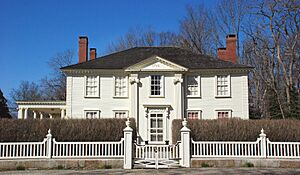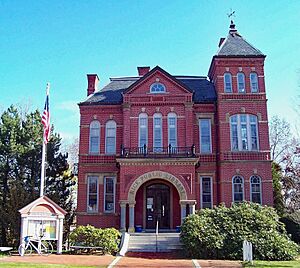Kittery, Maine facts for kids
Quick facts for kids
Kittery
|
||
|---|---|---|

|
||
|
||
| Motto(s):
Gateway to Maine
|
||
| Country | ||
| State | ||
| County | York | |
| Settled | 1623 | |
| Incorporated | 1647 | |
| Area | ||
| • Total | 75.30 sq mi (195.03 km2) | |
| • Land | 17.78 sq mi (46.05 km2) | |
| • Water | 57.52 sq mi (148.98 km2) | |
| Elevation | 23 ft (7 m) | |
| Population
(2020)
|
||
| • Total | 10,070 | |
| • Density | 566/sq mi (218.7/km2) | |
| Time zone | UTC−5 (Eastern (EST)) | |
| • Summer (DST) | UTC−4 (EDT) | |
| ZIP Code |
03904
|
|
| Area code(s) | 207 | |
| FIPS code | 23-37270 | |
| GNIS feature ID | 0582544 | |
| Website | www.kitteryme.gov | |
Kittery is a town in York County, Maine, United States. It is the oldest incorporated town in Maine.
Kittery is home to the Portsmouth Naval Shipyard. This shipyard is located on Seavey's Island. The town also includes Badger's Island and the seaside area of Kittery Point. Part of the Isles of Shoals also belongs to Kittery.
Kittery is the southernmost town in Maine. It is a popular place for tourists. Many people visit its outlet stores. In 2020, about 10,070 people lived in Kittery.
Contents
History of Kittery
English settlers first came to the Kittery area around 1623. This was near the natural harbor of the Piscataqua River. By 1632, a fort called Fort William and Mary protected the community. Later, in 1689, Fort McClary was built on the Maine side of the river.
Kittery officially became a town in 1647. This makes it the "oldest incorporated town in Maine." It was named after Kittery Court in England. This was the birthplace of Alexander Shapleigh, one of the town's founders.
Shapleigh arrived in 1635 with Captain Francis Champernowne. They helped set up fisheries near the Isles of Shoals. Here, fish were caught, salted, and sent to Europe. Other early settlers were hunters and loggers. They used the area's rich timber.
An important early settler was Thomas Spencer. His family story is in a book called The Maine Spencers. Another pioneer was Francis Small. He ran a trading post and became a very large landowner in Maine.
In 1663, a writer named John Josselyn said Kittery was the most populated town in the area.
During the colonial era, many enslaved people were brought to Kittery Parish. They were forced to work and live under very difficult conditions. One notable figure, Sir William Pepperrell, was a merchant and soldier from Kittery. He was also known to have enslaved people.
In 1705, during Queen Anne's War, Native American tribes raided Kittery. Six residents were killed, and five were taken prisoner.
During the Revolution, the first ships of the U.S. Navy were built on Badger's Island. One famous ship was the USS Ranger. It was led by John Paul Jones.
The Portsmouth Naval Shipyard was started in 1800. It was the first federal navy yard in the nation. During the Civil War, the shipyard rebuilt the USS Constitution. It also built the USS Kearsarge.
In 1905, a very important event happened here. The Treaty of Portsmouth was signed at the shipyard. This treaty officially ended the Russo-Japanese War.
From 1946 to 1977, Rock Rest was a special guest house in Kittery Point. Clayton and Hazel Sinclair ran it. It offered lodging to Black vacation travelers during a time of racial discrimination. Rock Rest is now on the National Register of Historic Places.
Kittery's Geography
Kittery covers about 75 square miles (195 square kilometers). Most of this area is water. The town is located by the Gulf of Maine and the Atlantic Ocean. Several creeks and the Piscataqua River flow through Kittery.
Major roads like Interstate 95 and U.S. Route 1 cross through the town.
Population of Kittery
In 2020, Kittery had a population of 10,070 people.
Kittery's Economy
The Portsmouth Naval Shipyard is very important to Kittery's economy. Many people in Kittery work there. The shipyard brings a lot of money into the region.
The Kittery Outlets is a large outdoor shopping area. It has over 100 stores, including big national brands. Part of the outlets will be replaced with apartments, a hotel, and a restaurant.
Kittery Foreside is a popular area near the shipyard. It has many shops, restaurants, and cafes. It also has historic homes and places for arts and culture.
The Weathervane Restaurant chain started in Kittery in 1969. Kittery is also known for having many vegan and vegetarian restaurants.
Climate Change in Kittery
Kittery's coastal areas are at risk from rising sea levels. This is due to climate change. Low-lying roads, bridges, businesses, and the shipyard could be affected.
To deal with these threats, Kittery has a Climate Change Adaptation Committee. This group works on ways to protect the town.
Arts and Culture in Kittery
The Kittery Art Association started in 1958. It has a gallery at 2 Walker Street. This gallery is a place for art shows and cultural events.
The Rice Public Library was built in 1889. It recently had a big renovation and reopened in 2022.
The Dance Hall is a nonprofit organization. It is located in the old Grange Hall. It offers dance and music performances and classes.
Places to Visit
- William Pepperrell House, built in 1733
- Lady Pepperrell House, built in 1760
- John Bray House, built in 1662, one of the oldest houses in Maine.
- John Paul Jones Memorial Park, with a memorial for sailors and soldiers.
- The Kittery Historical and Naval Museum, opened in 1977.
- Seapoint Beach and Fort Foster, a former harbor defense site.
- Fort McClary State Historic Site
- Rock Rest
- Kittery Community Center
Parks and Recreation in Kittery
Kittery has many parks, beaches, and places for fun. The biggest is Fort Foster. It used to be a military base.
Other parks include:
- John Paul Jones Memorial Park
- Fort McClary State Historic Site
- Inspiration Park
- Rogers Park Conservation Area
- Kittery Memorial Field
- Cutts Island Trail on the Rachel Carson Nature Preserve
Beaches in Kittery:
- Seapoint Beach
- Crescent Beach
- Fort Foster Scuba Beach
- Fort Foster Horn Point - East Cove Beach
- Fort Foster Pier Beach
Education in Kittery
Kittery has several schools. Robert William Traip Academy is for grades 9-12. Horace Mitchell Primary School is for kindergarten through 3rd grade. Shapleigh School is for grades 4-8.
Kittery in Media
The movie Thinner (1996) was filmed in Kittery. This movie was based on a Stephen King novel.
Notable People from Kittery
- Jess Abbott, guitarist for the band Now, Now
- John Haley Bellamy, woodcarver and folk artist
- Dennis C. Blair, admiral
- Scott Brown, former senator and ambassador
- William Dean Howells, writer and editor
- John O'Hurley, television actor
- Sir William Pepperrell, merchant and soldier
- Francis Small, trader and landowner
- Celia Thaxter, poet
- William Whipple, a signer of the Declaration of Independence
Images for kids
See also
 In Spanish: Kittery (Maine) para niños
In Spanish: Kittery (Maine) para niños





